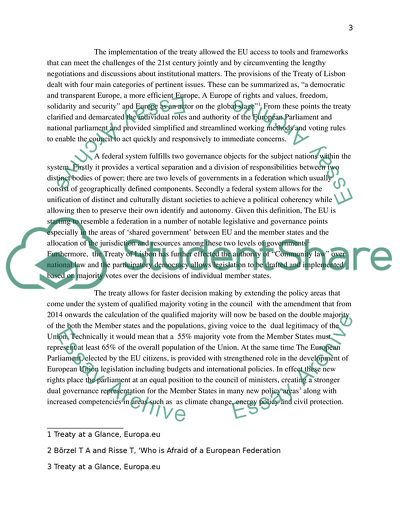Cite this document
(The Treaty of Lisbon Report Example | Topics and Well Written Essays - 1500 words, n.d.)
The Treaty of Lisbon Report Example | Topics and Well Written Essays - 1500 words. https://studentshare.org/law/1843211-to-what-extent-has-the-treaty-of-lisbon-moved-the-european-union-closer-to-a-federal-set-up-discuss-this-question-with-reference-to-both-the-provisions-of-the-tol-and-previous-treaties
The Treaty of Lisbon Report Example | Topics and Well Written Essays - 1500 words. https://studentshare.org/law/1843211-to-what-extent-has-the-treaty-of-lisbon-moved-the-european-union-closer-to-a-federal-set-up-discuss-this-question-with-reference-to-both-the-provisions-of-the-tol-and-previous-treaties
(The Treaty of Lisbon Report Example | Topics and Well Written Essays - 1500 Words)
The Treaty of Lisbon Report Example | Topics and Well Written Essays - 1500 Words. https://studentshare.org/law/1843211-to-what-extent-has-the-treaty-of-lisbon-moved-the-european-union-closer-to-a-federal-set-up-discuss-this-question-with-reference-to-both-the-provisions-of-the-tol-and-previous-treaties.
The Treaty of Lisbon Report Example | Topics and Well Written Essays - 1500 Words. https://studentshare.org/law/1843211-to-what-extent-has-the-treaty-of-lisbon-moved-the-european-union-closer-to-a-federal-set-up-discuss-this-question-with-reference-to-both-the-provisions-of-the-tol-and-previous-treaties.
“The Treaty of Lisbon Report Example | Topics and Well Written Essays - 1500 Words”. https://studentshare.org/law/1843211-to-what-extent-has-the-treaty-of-lisbon-moved-the-european-union-closer-to-a-federal-set-up-discuss-this-question-with-reference-to-both-the-provisions-of-the-tol-and-previous-treaties.


